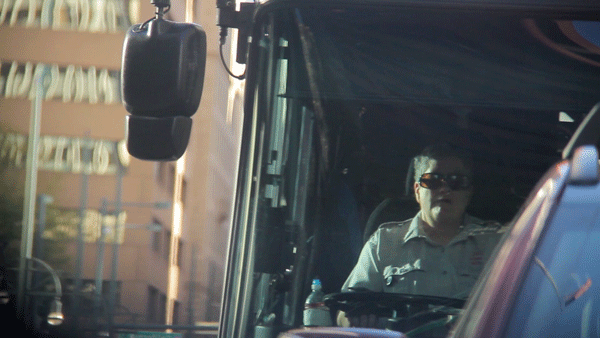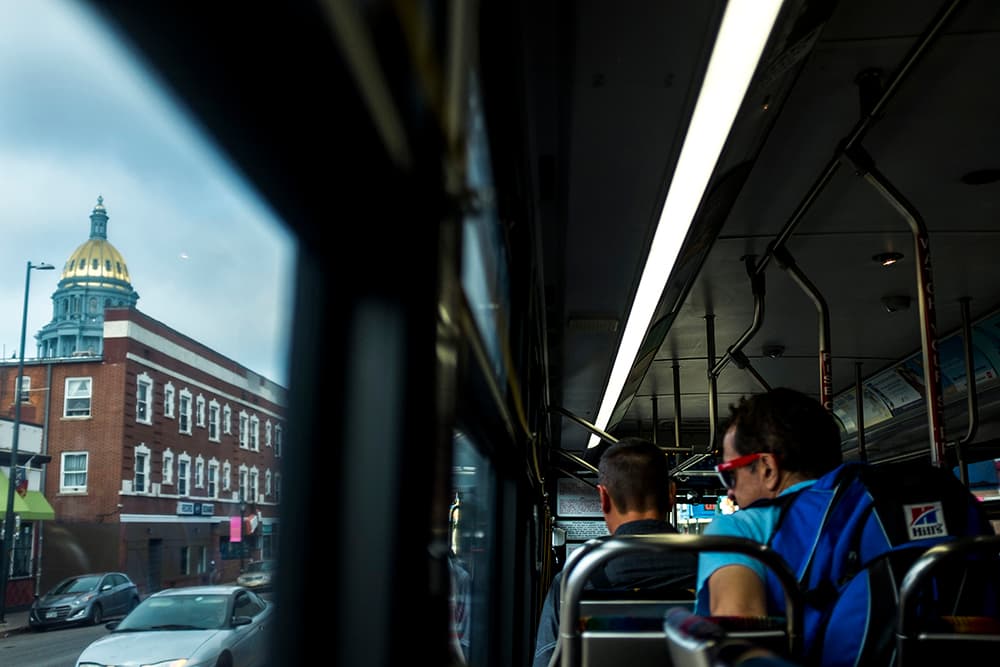
The Regional Transportation District has a driver shortage problem and it knows it.
As the agency struggles to retain bus drivers or even hire them in the first place, service suffers. A report presented at a Nov. 14 board meeting laid out the number of service hours RTD buses were losing each month of each year for five years — documenting a rise from about 73 lost hours in 2013 to about 5,185 just through October of 2017.
Bruce Abel, RTD's assistant general manager for bus operations, says that's less than half of 1 percent of service hours. But that's "a statistical measure, not a human measure."
"If you’re Mrs. Smith standing on the corner of Oak and Eighth and it happens to be your bus," he said, "then it becomes a far greater challenge."
The simple explanation for the driver shortage lies in the economy. But unlike most problems blamed on the economy, this has to do with economic strength. Essentially, as jobs returned and unemployment dropped, people were less and less interested in driving a bus for a living.
When things started getting better in 2015, RTD and the contractors who provide 45 percent of its service started having trouble with staffing, and with fewer bus drivers come missed and late runs.
"What happened in 2015 — you will see it going up both on the contractor side and the RTD side," Abel said of the report showing lost service hours. "What you see is — and it really began occurring in mid-’15, where we began seeing numbers of any substance — we see fewer operators available, for example, to fill in if someone calls in sick. These are the things that lead to pullout delays or missed runs."
You can comb through RTD's report yourself for month-to-month numbers and percentages, but here's what that lost-service-hour data looks like annually:
One note on those numbers: 443 lost service hours in 2016 are attributed to the snowstorm Feb. 1-3.
"The biggest concern, of course, is that you can’t really maintain the reliability of our transit system. The workhorse of the transit system is the bus," said Kathleen Osher, executive director of the Transit Alliance. "[National surveys show] that what customers like the most are reliability and frequency. We often times get stuck thinking, well if I put WiFi on the bus, everyone will love it. But it has a lot more to do with the frequency of service and the reliability."
Here's what we heard from some Mrs. Smiths.
From a wonky transportation industry perspective, losing less than half of 1 percent of all service hours isn't so bad. As Abel said, "If one looks at it from a statistical point of view, most folks in this business would be pleased with that."
But RTD knows that that tiny percentage has big real-world effects — and people who ride the buses know it, too.
Denverite asked readers about their experiences with RTD, and the responses showed us the simmering frustration:
"I used to teach at the University of Colorado at Denver and took the bus (32) to work almost every day (I left my position there just a couple months ago). Anyways, the bus was either late (like way over 10-15 minutes late) or did not come at all at least 20 percent of the time, and I think I'm being generous with that figure. I had to take an Uber or Lyft from the bus stop at least one day a week to make it to my classes on time. One particularly frustrating aspect of this was the total unreliability of the RTD app, which I have on my phone. The bus arrival times were very rarely updated to reflect these delays. At any rate, I cannot imagine what I would have done if I did not have the luxury of paying for an Uber or Lyft to supplement my bus travel, as was the case for so many of my students. So many students at the Auraria campus rely on RTD. They are experts on their services. My sense from talking to them is that certain bus lines are far more reliable than others." — Sarah Olivier
"I ride the FF4 from the 1st Bank Center to Civic Center every day, or at least I would like to. More often than not it’s standing room only, which for a 30-minute bus ride down I-25 is really uncomfortable. It’s a kind of snowball effect, where one bus is late or full, so people pile up to ride the next one." — Kevin McKernan
"I have always owned a vehicle, so my experience with public transit in Denver is comparatively limited to jaunts on the 15L or 10 between the City Park/Congress Park and LoDo neighborhoods. Still, I ride enough to know that the service is often irregular and inefficient — particularly on Colfax — and this is so frustrating! Some mornings, the wait at Colfax and Josephine for the westbound 15L is just a few minutes; other mornings, it could take 20-30 minutes. There are also many occasions when multiple buses arrive at the same time, one behind the other ... I have seen as many as five buses stacked up, but the most maddening aspect is that a trailing bus seems forbidden to overtake a leading bus. The stacking also occurs with regularity on the 16th Street Mall, ... As an example of the timing of buses or shuttles, I could walk nearly the entire length of the Mall (15 minutes) before a shuttle appears, and have walked from 17th & Wazee to Broadway & Colfax, then on to Josephine without ever seeing a 15L (45 minutes)." — Vicki Taniwaki
"For the fall through November, catching a bus out of town has been a freakshow. I don't know what the buses are doing but they're sometimes 40 mins late, which is strange when they're scheduled to run every 15 minutes at rush hour. ... It seems to get worse as the weather gets worse which is always frustrating. " — Amy Hollrah
For many people, too, this is more than inconvenient. When public transportation is your only mode of transportation, chronic bus delays lead to chronic lateness to work, which in turn has varying degrees of consequences depending on a person's job. Lost service hours translate to lost jobs, not to mention missed appointments or special occasions.

And while Denver Public Schools has no way of tracking how many or how often students are late because of delayed or dropped bus trips, we know students rely on RTD services. This November, DPS ordered RTD passes for 2,755 qualifying students, senior media relations specialist Jessie Smiley told Denverite.
"There are some areas (like near Northfield High School for example) where there is demand for more frequent RTD routes to/from school, but adding additional buses would not be feasible or profitable for RTD as a company," Smiley wrote in an email. "That may be due, in part, to a shortage of RTD drivers, but since the ridership would be solely students at select times of day, additional routes would not garner additional riders in the public."
Osher said it's about more than just getting to and from school. Youth not old enough to drive or from low-income families rely on buses to get everywhere they need and want to go. And, she added, they're the people you really want to make happy if you want to ensure the future of public transportation.
"I think the national experience is that if you can really capture the heart of a transit rider before they’re 20 or 21, you make a lifetime rider," she said.
So how do we solve a driver shortage?
Clearly, it's not as simple as hiring more drivers.
In a city where the unemployment rate is a very low 2.2 percent, there just aren't many people looking for jobs in the first place. For those who are, there are a few reasons driving bus is unappealing.
"A couple of things that people continuously focus on are the uptick of the economy," Osher said," The second being of course the legalization of pot. There are a couple of different factors there, but also it’s not an easy job, for sure."

RTD drug tests drivers, of course, which Osher says deters anyone who wants to legally smoke marijuana. As of right now, RTD has not mentioned any plans to change that policy.
And while the difficulty of the job leads to fewer people wanting it, fewer people doing the job makes it more difficult. With fewer drivers, everyone is asked to do more, and that's far from ideal, Abel said. It's a downward spiral from which RTD is struggling to pull out.
What it can do, and what it's already trying to do, is pay drivers more and offer compensation for the especially unpleasant parts of driving a bus.
The starting hourly wage right now is $17.59 — more than $5 above minimum wage — and drivers get benefits including health care and a retirement savings program. Right now, RTD is offering a $2,000 starting bonus, and Abel said they've instituted incentives to keep drivers once they're onboard, too. There's a bonus for drivers who work split-runs, which means they work two different shifts at peak hours rather than one continuous shift throughout the day, and there's an extra $2-per-hour on the table for drivers who pick up work above and beyond their normal work.
RTD has been out recruiting at job fairs and anywhere else Denverites are looking for work. It's also using on-bus ads to try to attract applicants.
Osher says it might take more than that.
"We as a state, Colorado — it’s been almost 18 years since we’ve asked for any sort of transportation funding. We’ve got people in their late 20s who have been voting for more than 10 years and they’ve never had a chance to say yes to transportation."
If working as an RTD bus driver does interest you, you can learn more at rtd-denver.com.












